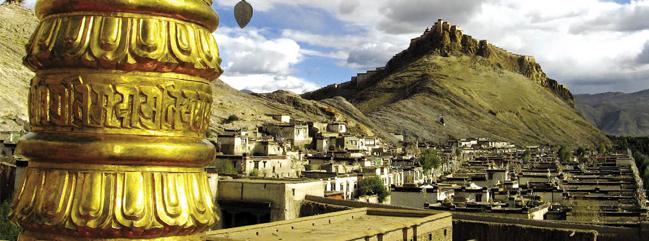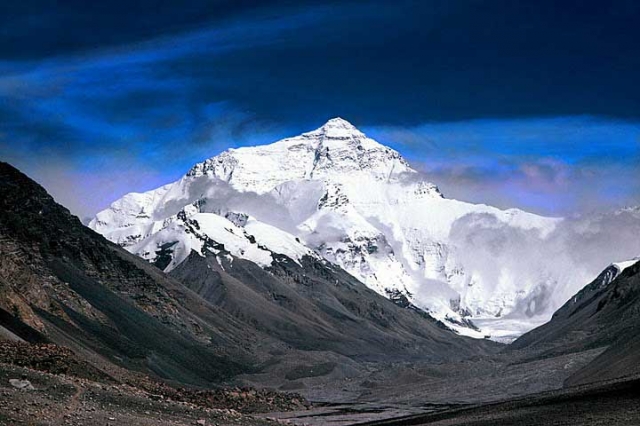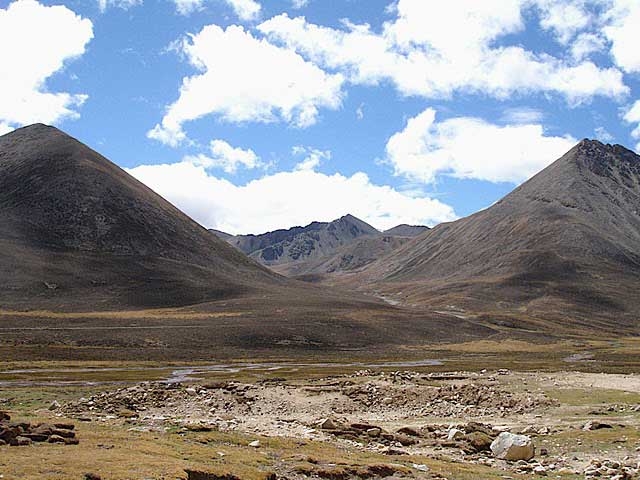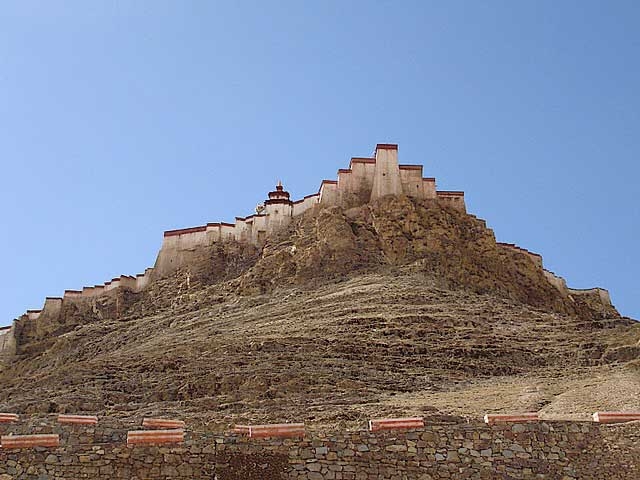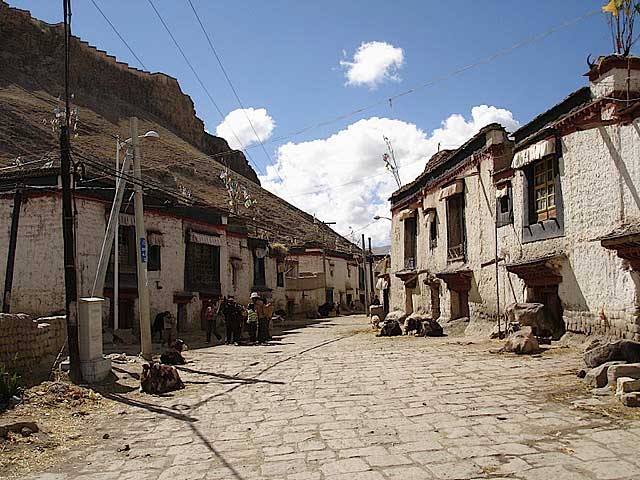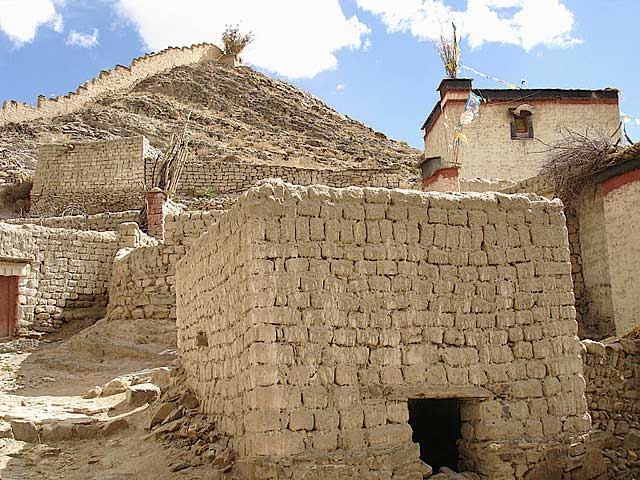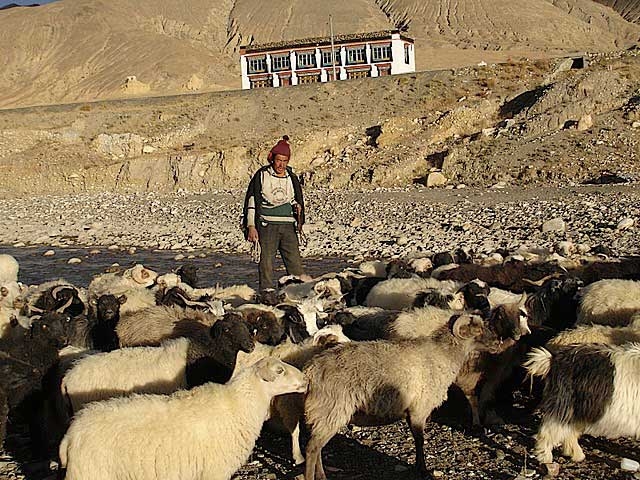An hour Flight from Kathmandu to Lhasa across the mount Everest is a wonderful scenic view of Kanchenjunga and Makalu as well. Following Lhasa Tours we drive through Shigatse and to Kharta valley meeting with our Nepalese staffs. Climbing the Balung Peak -will be rewarded with fantastic views towards the Mount Cho Oyu- 8201 meter.
Five o’clock in the morning still dark and very quite and temperature minus 16 Celsius with overnight snow fall, the altitude is 5370m. It doesn’t matter; it is time to dress up, to warm the boots, to have a breakfast and to start. Slowly and always in mind not to consume more oxygen. Sufficient liquid is a must for heading up slowly. Far away the view of Mt. Cho Oyu and in front Nagpa La. Since centuries this 5716m high pass is used as a way to Solu Khumbu in Nepal. In Olden days Nangpa la was a trade route.
After three hours the altitude meter shows 5800m.. We fight against the altitude, crossing 6100m, 6200m. On the ridge we continue up to the beginning of the steep and icy flank of the Balung Peak. At the highest pint of he ridge the measures 6380m- now to descend. . Everybody thinks now about the difficult way back: hours and hours through snow and on nearly impassable trial. Reaching the top is not everything and will get problems during the apparently never-ending descent, however we feel in excellent mood having reached the summit of 6404 m.
Day 01- Arrival in Kathmandu Airport (1345meters).
There you will be met by our Airport Representative and transferred to hotel by private tourist vehicle. Overnight at hotel.
Day 02- Pre-trip Meeting and Sightseeing around Kathmandu valley.
In the morning after breakfast at 9 AM, we host a Pre-Trip meeting at your hotel in Kathmandu and introduced your tour and trek Leader/Guide mean time and it will provide an opportunity for individuals to ask questions about the your tour and to introduce you to other participants. This includes a final briefing and preparations for the trip.
PLEASE ADVISE US IF YOU WILL BE ARRIVING LATE AND ARE THEREFORE UNABLE TO ATTEND THE PRE-TRIP MEETING.
In THE PRE-TRIP MEETING All passengers MUST bring:
1. Passport.
2. Four copies of Passport size photos each.
3. Travel Insurance Policy.
4. A writing pen
5. Notepad.
After the Pre-Trip meeting and breakfast your sightseeing trip will start at 9.45 AM in the morning. We provide a private vehicle and professional tour guide. We visit Bodhnath Stupa, one of the biggest Buddhist shrines in the world, where we observe Buddhist monks in prayer in the monasteries surrounding the stupa. After Bodhnath Stupa we visit Pashupatinath, the most famous Hindu temple in the country, located on the banks of the holy Bagmati River. Here we see Hindu holy men (sadhus) meditating, pilgrims bathing and occasionally funeral pyres burning on the ghats. We also visit Bhaktapur Durbar Square, which is a collection of pagoda and shikhara – style temples grouped around a fifty-five-window palace of brick and wood. The attraction of the Bhaktapur Durbar Square is The Lion gate, The Golden gate, The Palace of fifty five windows, Art Galleries, The Statue of King Bhupatindra Malla.
The rest of our time in Kathmandu is free for further exploration and some last-minute shopping in Thamel area near by your hotel. Later, we are supplied with our Trip Pack and departure information for tomorrow. Overnight at hotel.
Day 03- Fly from Kathmandu to Lhasa (3660meters).
Early morning transfer to the international airport for the hour-long flight to Lhasa. This stunning flight, on a China Southwest Airlines Boeing 757, takes us right across the main Himalayan range and provides us with magnificent mountain views. After landing at Gongar Airport and meeting our Tibetan guide, it is a further 2-hour drive by Land cruiser to Lhasa. It’s advisable to rest and take it easy for the remainder of the day due to Lhasa’s altitude. Overnight at hotel.
Day 04- Sightseeing in Lhasa.
We spend today visiting several of Lhasa’s many monasteries in the company of a guide and interpreter. One of these is the Sera Monastery, one of the best-preserved monasteries in Tibet, within its whitewashed walls and golden roofs, several hundred monks live and study. After lunch we’ll visit the Norbulingka, the summer palace of the Dalai Lama, as well as the Jokhang Temple. This temple is possibly the most sacred shrine in Tibet and there is always a procession of devout Tibetans through the complex. Surrounding the Jokhang is the Barkor – a maze of narrow cobbled streets that is the central market of Lhasa. Overnight at hotel.
Day 05- Second day of sightseeing in Lhasa.
In the morning, we visit Potala Palace which dominates the city of Lhasa it’s a spectacular building, containing private quarters of the Dalai Lama as well as numerous grand state rooms and many important chapels. There has been a Palace on this site since the 5th or 6th century, but the present Palace was constructed in the 17th century. After lunch, we visit the Drepung Monastery, which was founded in the 14th century and was once the largest in the world, with a population of around 10,000 monks. These days that figure is down to several hundred, but there is still much here of interest as it was left relatively unscathed during the Cultural Revolution. Overnight at hotel.
Day 06- Drive Lhasa to Gyantse (3950meters) – 261 k.m
The day begins with our overland journey towards Rongbuk valley. We follow the Friendship Highway by jeep, we cross the Khamba La at elevation of 4794meters from which there are stunning views across the waters of Yamdrok-tso Lake to the snowy summit of Nazin Kang Sa 7252meters. As we continue our journey to westwards over another high pass the Karo La 5045meters, we can view the spectacular sight of a huge glacier tumbling down to within a few hundred meters of the road. After few hours, we arrive to Gyantse passing the beautiful valleys and colourful Tibetan villages. Overnight at hotel.
Day 07- Drive to Shigatse (3900meter) – 90 k.m.
This morning we visit the Gyantse Dzong. This fort dates back to the fourteenth century and offers some of the most amazing views of Gyantse and surrounding valleys. Before leaving we also visit the famed Gyantse Kumbum. This magnificent tiered structure is the largest stupa in all of Tibet. If the exquisite gold dome is not enough, this stupa is packed with Tibetan sculptures and paintings.
Thereby, we continue the trip to Shigatse, the second largest city in Tibet. It is only about a 90 km drive taking us to Shigatse which is a laid back city that provides excellent opportunity for both relaxation and exploration. Thereafter, exploring the local market we will make a detailed visit to the Tashilhunpo Monastery, one of the largest functioning monasteries in Tibet. Overnight at hotel.
Day 08- Drive to Shegar (New Tingri) (4050meters) – 244 k.m.
The views of this desert plateau provide wondrous entertainment as we travel along the Friendship Highway. This stretch is the most spectacular landscape in Tibet. After passing through the small town of Lhatse we will cross Gyatmso La elevation of 5220meters, the highest pass on our journey. The land quickly descends to plains after Gyatmso La. While travelling through the plains we will see many nomadic herders, quiet countryside, and secluded monasteries. Overnight at hotel.
DAY 09- Shegar to Khrta
Trek to Khrta, camp
DAY 10- Khrta to Tangmoche
Trek to Tangmoche, camp
DAY 11- Tangmoche to Saga
Trek to Saga, camp
DAY 12- Climbing Day
Climbing Doya Ri, camp
DAY 13- Rongbuk
Trek to Rongbuk, camp
DAY 14- Everest Base Camp
Trek to Everest Base Camp, camp
DAY 15- Cho oyu Camp
Trek to Cho Oyu CBC, camp
DAY 16- Bhalung Camp
Trek to Bhalung Ri BC, camp
DAY 17- Bhalung Ri
Summit Bhalung Ri (6404m) – BC
DAY 18- Tingri
Drive to Tingri, lodge/camp
DAY 19- Zhangmu
Drive to Zhangmu, hotel
DAY 20- Back to Kathmandu
Drive to Kathmandu, hotel
DAY 21- Rest day at Kathmandu
Free day at Kathmandu, Overnight stay at hotel
DAY 22- Final Departure
The trip ends, our Airport Representative will drop you to the Kathmandu International Airport for your flight departure from Nepal.
NOTE: The above information is a guide and standard template of what we provide. The trek can be customized at your request to accommodate your specific requirements.
Note : On adventure trips of this type, weather, local politics, transport or a multitude of other factors beyond our control can result in a change of itinerary. It is, however, very unlikely that the itinerary would be substantially altered; if alterations are necessary the leader will decide what is the best alternative, taking into consideration the best interests of the whole group. Where a change does occur, we do everything we can to minimize its effect, but we cannot be responsible for the results of changes or delays.
Q.What type of shape do I need to be in, is this trip for me?
A. Trekking is suitable for average people who are moderately fit, thus no previous experience is required. Some physical fitness programs such as running, swimming, hiking is recommended before you embark on your journey. Persons suffering from a pre-existing medical condition or disease must seek medical advice before considering the trek. Whilst on the trek, it is common to experience some discomfort before being fully acclimatized.
To prepare for a strenuous trek you should begin training at least two to three months before your departure. As a guideline, an hour of aerobic exercise three to four times per week would be considered a minimum requirement. The best preparation is bushwalking involving relatively steep ascents and descents. If you can manage a couple of valley floor to ridgeline ascents per comfortable and able to enjoy the trek to the fullest. They are physically strong, sharp-witted and have an incredibly positive attitude towards a life that we would consider extremely tough. There is something about a trek in the Himalaya that draws you back time and time again. For keen walkers it is a paradise and even avowed non-walkers find that one foot just seems to follow the other, drawn by the appeal of what lies beyond.
Q. Will somebody come to pick me up at the Airport upon my arrival?
A. Yes, our Airport Representative will be there to greet you outside of Terminal Hall, he/she will be displaying an Kiwi Adventures Treks & Expedition sign board. Upon arrival, you will be transferred to your hotel.
Q. What sort of accommodation can I expect in Kathmandu and in trekking?
A. 11 night’s Trekking Guesthouse, 4 nights three/four star hotels in Kathmandu.
We use standard rooms from three/four star hotels in Kathmandu with breakfast included. Along the trekking routes teahouses/Lodges generally provide basic clean facilities with a mattress and a quilt or blanket. We can also offer you sleeping bags if needed (which need to return after the trip) but it is a good idea to always have your own sleeping equipment. We usually provide single and double rooms as well as the occasional dormitory. The dining room is downstairs around a fire. All food will be cooked to order in the little kitchen. You should not enter the kitchen unless asked to do so.
Q. What sort of food can I expect in trekking?
A. In trekking most teahouses (lodges) cook a delicious range of mostly vegetarian fare. Pasta, tuna bakes, noodles, potatoes, eggs, dhal bhat, bread, soups, fresh vegetables (variety depends on the season) and even some desserts like apple pies, pancakes, and some interesting attempts at custard. You will find a lot of garlic on the menu because it assists with acclimatization – eat some every day. In many larger villages you may find some meat on the menu. You can always get hot chocolate, tea, and hot lemon drinks, as well as soft drinks, and treats like chocolate and crisps.
Each day dinner and breakfast are used to take in the same lodge you spend the night. Lunch will be taken on the way to destination.
Q. What sort of transportation you use?
A. Kiwi Adventures Treks & Expedition is all about providing you with local insights as well as adventure, with that in mind, where we think you will get more out of your holiday by using different means of transport that is what we do. Using a variety of private transport is an integral part of our Himalaya tours and enhances the experience!
We use private tourist vehicles for sightseeing, city tours and pickups. Depending on the group size we use cars, minibus, van or land cruiser. These small light vehicles are more manoeuvrable and flexible enabling us to take you through the Narrow roads of Nepal. All the vehicles are usually air-conditioned unless we are travelling in cooler areas.
Q. What is the best season for this trekking?
A. Our trekking season extends from mid- September to May. From early September the monsoonal rains decrease. By end of September through to December the weather is usually stable with mild to warm days, cold nights. February, March, April, May, October, November, December are the best time to do trek.
Q. What is the weather & temperature like in trekking?
A. Weather in the mountains is notoriously difficult to predict. At night it is generally cooler the days are generally warm. Winter (January and February) will be bit colder but the days can be quite beautiful and warm if the sun is out. There will be bit of snow during the month of January, February and December. It is also important to make sure that you can stay warm and dry in just about any conditions. Expect the unexpected! The temperature could be as high as 20 deg C to -15 deg C low.
Q. Can I charge my digital camera or other batteries on my trip?
A. These facilities will be available in most of the places in your hotel reception by paying some service charges. Remember to bring your adapters!
Q. Is there any communication while we are on trekking?
A. There are telephones in some villages along the trekking routes from which you can make international calls.
Q. Can I use credit cards in the places visit in trekking?
A. In most cities yes, to some extent, however once you leave those cities behind, all you need is cash.
Q. How much additional money do I need per day?
A. In Kathmandu, you can allocate US$ 10 – 25 for a lunch / dinner. It’s all depends on your spending habits. US$7 to 10 US$ a day will be enough to buy bottles of water, chocolates and few drinks in trekking.
Q. Do I need to tip my guide and porters? How much would that be?
A. This is a difficult thing to gauge. We have seen everything from 20USD to 1000 USD per person for guides and porters. Tipping is not required, but a small way to show your guides and local porters thanks for their help. The level of the tip should reflect the level of personal involvement with your guide.
Q. Is the water OK to drink? Do I need to bring purifying tablets/filter?
A. In most places bottled water is readily available. If you wish to drink normal water, you need to use purifying aid, which you will need to bring with you.
Q. Are the Kiwi Adventures Treks & Expedition staff insured?
A. Our company insures all our trekking staff, including guide, cook, sherpa and porters.
Q. What essential documents do I need to bring with me on tour?
A. *Valid Passport – must be valid for up to 6 months after you return from your tour, keep a separate photocopy.
*Travel insurance, keep a separate photocopy
*Cash and Traveller’s Cheques, keep numbers and proof of purchase separate
*Flight tickets
*Emergency contact numbers for T/C’s, banks, insurance, family contacts.
Q. Can I add extra days to my trekking trip?
A. A hoilday should never be about making it to the final point quickly. Along your trek we can add days at your request with additional costs to cover guides, porters, accommodation and food.
Q. Do you use yaks/porters on the trek or do we carry all of our own gear?
A. Whilst on the trek, our porter will take care of your luggage. All you need to carry is your small day bag for your personal belongings like camera, water bottle, sun cream etc only.
Q. What opportunities will I have for shower along the trek?
A. In major places, we arrange guesthouse with hot shower. And in rest of the places, hotel water in bucket will be provided for shower; it would cost you extra about USD 3-4 per shower.
Q. Do you know about how many total miles the trek is?
A. Total distance of the entire trek is about 75 miles.
Cost Includes
• 4 nights 3 stars hotel in KTM on B/B
• Sirdar, Cook, Sherpa, Kitchen boys,
• Helper, Yak & Yak man
• Food during the trek 3 meals a day
• 2 men tent, mattress, dinning tent,
• Kitchen tent, toilet tent, tables & chairs
• Insurance for all Nepalese staffs
• Flight Ktm-Lhasa
• Transportation: Zhangmu-KTM
• Lhasa hotel and lodge en-route on F/B
• Sightseeing in Tibet
• Local Tibetan guide
• Tibet entry & exit permit
• Transfer hotel-airport-hotel
• KTM sightseeing with guide
Cost Excludes
• Lunch & Dinner during KTM stay
• Entrance fees during KTM sightseeing
• Tibet Visa fee Euro 50 per person
• Personal equipment & Insurance
• International air ticket, airport tax
• Alcoholic beverages & telephone calls
• Nepal Visa fees US$ 30 Per person
• Emergency rescue evacuation if needed
